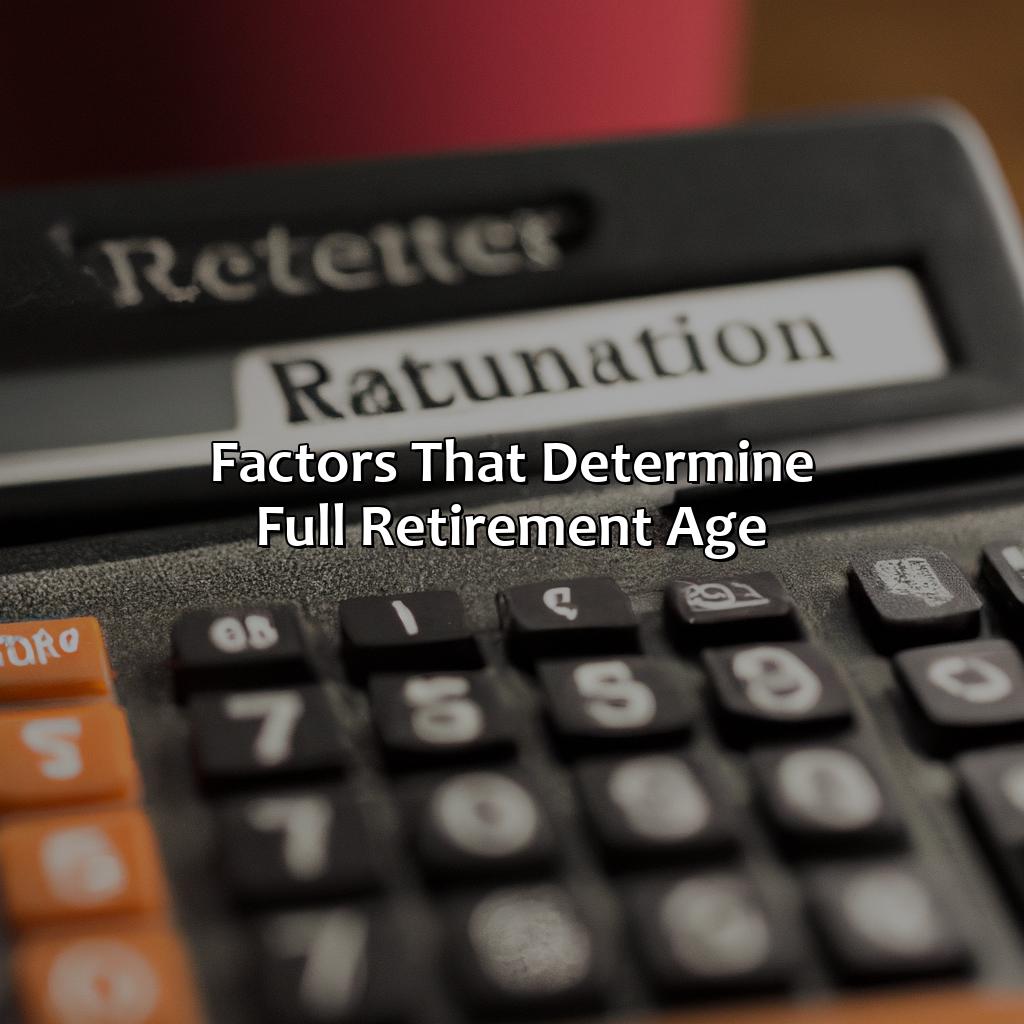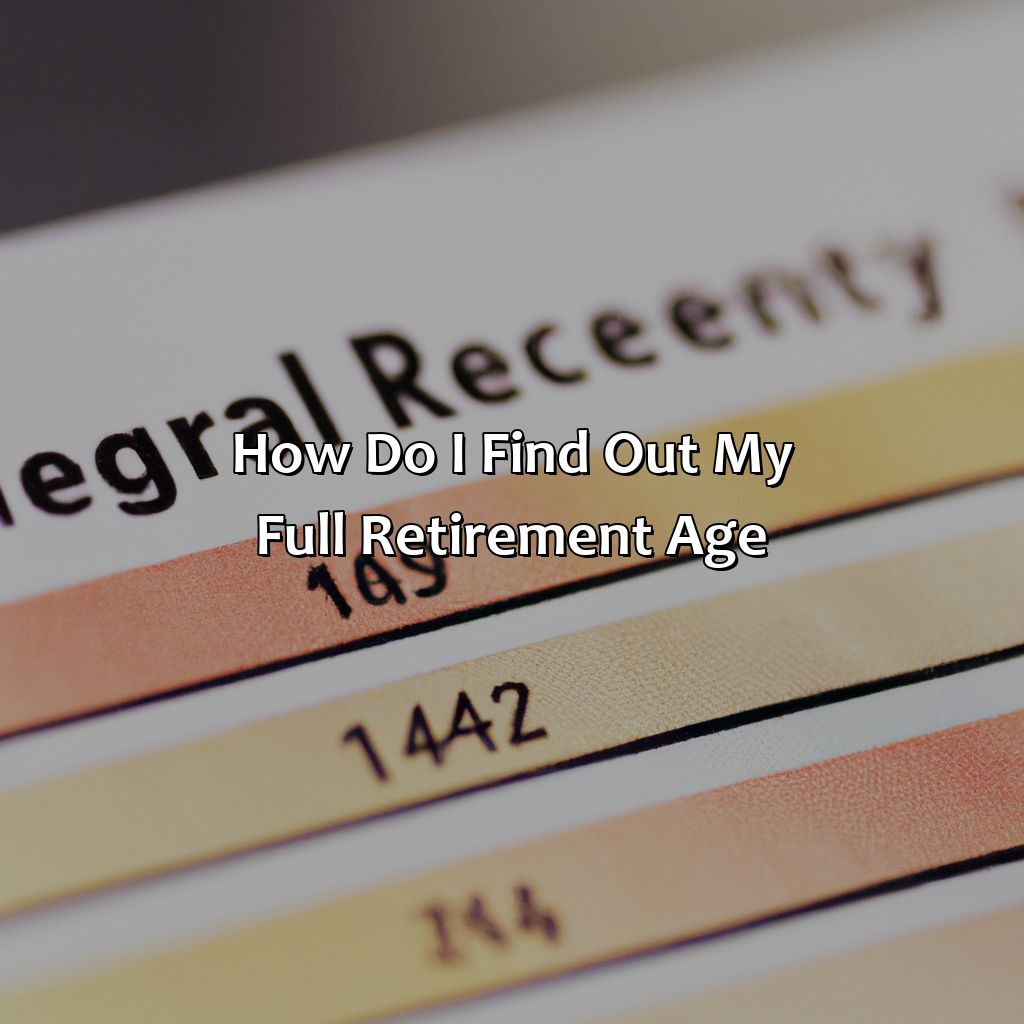How Do I Find Out My Full Retirement Age?
Key Takeaway:
- Full Retirement Age (FRA) is the age at which you become eligible for full Social Security retirement benefits, and it varies depending on your birth year.
- Several factors can affect your FRA, including your birth year, your retirement savings, your spouse’s work record, and your work history.
- There are several methods to find out your FRA, including using the Social Security Administration’s (SSA) website, checking your SSA statement, or contacting your local Social Security Office.
- Knowing your FRA is important for retirement planning, as it can affect the amount of Social Security benefits you receive and help you make decisions about when to retire.
- Retirement planning based on FRA should consider factors such as life expectancy, health care costs, and personal financial goals to ensure a comfortable and secure retirement.
Have you been counting down the days until your retirement? You must know your full retirement age to maximize the benefits you receive. You must understand the complexities involved in calculating it. Read on to learn how to find your full retirement age!
What is Full Retirement Age?
At what age can one retire comfortably and receive full benefits? The answer lies in understanding your Full Retirement Age (FRA). This is when you can receive 100% of your Social Security benefits. For those born between 1943 to 1954, your FRA is 66. For those born after 1954, the FRA increases gradually to age 67 for those born in 1960 or later.
To find out your FRA, you can refer to your Social Security statement, which is sent to you annually, or you can access it online through the Social Security website. Keep in mind that if you retire before your FRA, your monthly benefit amount will be permanently reduced. Delaying retirement beyond your FRA will increase your monthly benefit. It’s also important to plan for potential changes to the Social Security system that may affect your retirement plans.
To maximize your benefits, consider waiting until your FRA or later to retire. You can also continue to work and earn income while receiving Social Security benefits, but be aware that your benefits may be reduced if you earn more than a certain amount. Planning for retirement can seem overwhelming, but understanding your FRA is a crucial step in ensuring a secure retirement.

Image credits: retiregenz.com by Yuval Woodhock
Factors that determine Full Retirement Age
Factors That Contribute to Determining Your Full Retirement Age
Your Full Retirement Age is the age you become eligible for full Social Security benefits. The age at which you qualify for benefits depends on several factors that include your birth year and the age you choose to retire. Social Security uses a formula to calculate your Full Retirement Age based on these factors.
Your Full Retirement Age is calculated based on your birth year. The formula considers an increase of two months for every birth year. For example, if your birth year is 1955, your Full Retirement Age is 66 years and 2 months. However, if you choose to receive your benefits before your Full Retirement Age, your benefits are reduced accordingly.
Moreover, the age you choose to retire can also affect your Full Retirement Age. You have the option to receive your benefits as early as 62 years old, but your benefits will be reduced by up to 30% if you choose to retire at that age. However, if you delay your retirement until after your Full Retirement Age, you can receive a higher benefit amount, up to 8% per year.
It is essential to consider these factors to make informed decisions regarding your retirement benefits. Many factors can impact your life, and you may encounter challenges when managing your finances during your retirement years. For instance, my friend retired early at 62, but she realized later that her Full Retirement Age was 66 years and 2 months, causing her to lose a sizable portion of her benefits.
To sum up, understanding the factors that determine your Full Retirement Age is crucial when deciding when to retire and claim your Social Security benefits. By waiting until your Full Retirement Age, you can increase your benefits and live more comfortably in retirement.

Image credits: retiregenz.com by Adam Jones
Methods to Find out Full Retirement Age
Discover your Full Retirement Age with the Social Security Administration! You have three options: use the SSA website, get an SSA Statement, or contact the Social Security Office.

Image credits: retiregenz.com by David Woodhock
Social Security Administration’s (SSA) website
The digital space hosting the information on government retirement plans is an essential resource. However, if you are looking for your full retirement age, the site of the federal organization that provides social security services offers the most reliable options. The Social Security Administration’s (SSA) platform contains resources that specify how to calculate and determine your full retirement age.
Once on the SSA’s website, you can use their benefit calculators to determine your exact full retirement age based on when you were born. You will need to provide some personal and financial data, such as your date of birth and estimated future earnings to ensure that you estimate accurately. With this information obtained from the SSA website, making adequate plans for life after retirement becomes feasible.
In addition to obtaining one’s full retirement age, users of the SSA website can navigate various services provided by this impressive organization. The provision of services from medical assistance for disability appeals is what sets them apart.
Did you know? The Social Security Administration Act was passed by Congress and signed into law by President Roosevelt in 1935. It provided a social insurance program designed towards protecting citizens from certain adversities such as unemployment and old age pension.
Get your hands on the ever-elusive SSA statement, if you want to know your full retirement age. But be warned, it’s like finding a needle in a haystack, except the needle’s retirement age and the haystack’s a government bureaucracy.
SSA Statement
The Full Retirement Age statement by the Social Security Administration (SSA) determines the age at which a person can begin receiving full retirement benefits. To find out your Full Retirement Age, you can check your annual Social Security statement or use the online calculators provided on the SSA’s official website. These tools require details like date of birth and work history to generate accurate results.
Knowing your Full Retirement Age is crucial for planning your retirement as it affects the amount of social security benefits you receive. Additionally, delaying retirement beyond your Full Retirement Age results in increased monthly benefit payments until age 70.
It is important to note that a person’s Full Retirement Age varies depending on their birth year, ranging from 66 to 67 years old. This can affect decisions such as whether to retire early or delay retirement, and how much social security income to rely upon during retirement.
According to Forbes, over half of people claiming social security benefits take them before reaching their full retirement age, resulting in loss of money in monthly payouts.
Overall, it is essential to find out your Full Retirement Age accurately and make informed decisions regarding when to retire and how much to depend on social security benefits during your golden years.
Calling the Social Security office is like playing the lottery, you never know if you’ll get a helpful representative or someone who just wants to hang up on you.
Contacting Social Security Office
To discover your full retirement age, it can be highly beneficial to make contact with the social security office. Through this channel, you will receive accurate advice and guidance on exactly what benefits you are entitled to and when. The social security office is equipped with trained professionals who specialize in pensions and other social welfare services, making this the most reliable source of information on retirement planning.
By consulting with the Social Security Administration (SSA), you can learn everything necessary to maximize your benefits at retirement age. They will provide insight into specific strategies for optimizing your payments based on your unique circumstances and needs. You can initiate communication through the SSA’s website or over the phone, where their team is available Monday-Friday during regular business hours.
It’s worth noting that every phase of life has had different requirements when it comes to retiring. Retirements go beyond just pensions alone, even though they are an essential part of one’s golden years. There have been various means adopted by Western countries in coming to a consensus regarding longevity risk. A proactive approach is always the best path forward when considering plans for one’s later life.
Many individuals have already faced general life struggles; not knowing if they will eventually attain those long-term goals could be troublesome. The answer lies in seeking out appropriate information from authoritative sources such as financial advisors or relevant government agencies like Social Security Administration to determine what benefits are available today and tomorrow.
Life begins at full retirement age – or at least, the day you can finally retire from your annoying coworker.
Importance of Knowing Full Retirement Age
Knowing Your Full Retirement Age: Why It Matters
Retirement planning requires careful consideration of several factors, with the most important being your full retirement age. Understanding your full retirement age is critical as it determines the amount of your Social Security benefits. Beyond this, your full retirement age affects your overall retirement strategy, including when you can retire, how much you need to save, and how much you can earn while still receiving benefits.
Knowing your full retirement age enables you to plan ahead and make informed decisions about how and when to claim your benefits. Additionally, having this information allows you to create a personalized retirement plan that maximizes your income and minimizes your expenses.
Unfortunately, many people are unaware of their full retirement age, leading to missed opportunities and poor financial decisions. By being proactive and learning your full retirement age, you can take control of your retirement journey and ensure a comfortable and secure future.
A little-known fact is that the full retirement age has not always been fixed. In the 1930s, when Social Security was first introduced, the full retirement age was 65. However, as life expectancies increased, the full retirement age underwent several changes, eventually settling at age 67 for those born after 1960. Knowing the history of the full retirement age can provide valuable insight into how the system works and help you make informed decisions about your retirement plan.

Image credits: retiregenz.com by Yuval Jones
Retirement Planning based on Full Retirement Age
Explaining the importance of identifying one’s Retirement Age
Retiring at the right time is crucial for every worker. Understanding the Full Retirement Age can help workers plan for their financial future. The Full Retirement Age is the age you can receive the complete amount of Social Security retirement benefits.
Tips for Finding your Full Retirement Age
To find your Full Retirement Age, you can refer to the Social Security Administration’s website or speak to a professional financial advisor. Your Full Retirement Age is determined based on the year you were born, and it can range from age 66 to age 67. It is important to know your Full Retirement Age, as starting to receive your retirement benefits earlier than your Full Retirement Age can lead to a reduction in benefits.
Understanding Social Security Benefits beyond Full Retirement Age
Although your Full Retirement Age is when you can receive full Social Security benefits, it is possible to delay receiving benefits until age 70. Delaying benefits can result in a higher monthly benefit amount, which can provide financial security in retirement. However, it is important to consult with a professional financial advisor to assess if this strategy is right for your specific financial situation.
Suggestions for Retirement Planning based on Full Retirement Age
Planning for retirement based on your Full Retirement Age is crucial. To maximize your benefits, it is important to estimate your monthly retirement benefits and understand your spouse’s or ex-spouse’s benefit if applicable. Additionally, maintaining a healthy lifestyle and managing debt can help reduce financial stress during retirement. By taking these steps, you can ensure a comfortable retirement that fits your financial needs.

Image credits: retiregenz.com by Adam Woodhock
Some Facts About How To Find Out Your Full Retirement Age:
- ✅ Full retirement age varies based on year of birth and is determined by the Social Security Administration. (Source: SSA.gov)
- ✅ Full retirement age ranges from 66 to 67 years old for those born between 1943 and 1960. (Source: SSA.gov)
- ✅ Full retirement age is increasing gradually for those born in 1960 or later, with the full retirement age being 67 for those born in 1962 or later. (Source: SSA.gov)
- ✅ Taking Social Security benefits early can result in reduced monthly benefits, while delaying benefits can result in increased monthly benefits. (Source: AARP)
- ✅ It’s important to plan for retirement and the timing of Social Security benefits, taking into account factors such as life expectancy, financial needs, and employment status. (Source: Investopedia)
FAQs about How Do I Find Out My Full Retirement Age?
How do I find out my full retirement age?
Full retirement age varies depending on your birth year. You can use the Social Security Administration’s online calculator or check your Social Security statement to find out your full retirement age.
What if I was born on the first of the month?
If you were born on the first of the month, the Social Security Administration considers you to have been born in the previous month for the purposes of determining your full retirement age. That means your full retirement age is based on the previous month’s age.
Can I retire early?
Yes, you can retire as early as age 62, but your benefit will be reduced if you retire before your full retirement age. If you choose to retire early, your benefit will be reduced by a fraction of a percent for each month you retire before your full retirement age.
Can I delay my retirement?
Yes, you can delay your retirement past your full retirement age. If you delay retirement, your benefits will increase by a certain percentage for each year you delay retirement, up until age 70.
How do I apply for retirement benefits?
You can apply for retirement benefits online, by phone, or in person at your local Social Security office. You should apply three months before you want your benefits to start.
When will I start receiving my retirement benefits?
Your retirement benefits will start the month after you reach your full retirement age. If you choose to delay your retirement, your benefits will increase for each year you delay starting retirement, up until age 70.






